2023 TOYOTA 86 brakes
[x] Cancel search: brakesPage 192 of 449

1924-5. EyeSight
WARNING
●Ordinary roads (roads other
than those mentioned above)
• Depending on the driving envi- ronment (complexity of roads
and other factors), the system
may not be able to perform as
the traffic conditions require,
and that may result in an acci-
dent.
●Sharp curves or winding roads
●Frozen roads, snow-covered
roads or other slippery road sur-
faces
• The tires may spin, causing loss of control of the vehicle.
●Traffic conditions when fre-
quent acceleration and deceler-
ation make it difficult to maintain
the following distance
• It may not be po ssible for the
system to perform as the traffic
conditions require.
●Steep downhill grades
• The set vehicle speed may be exceeded.
●On a steep continuous downhill
grade
• The brakes may overheat.
●Roads and overpasses with
repeated steep uphill and down-
hill grades
• Detection of the vehicle in front may be lost, or the road surface
may be detected instead of the
vehicle in front, making correct
control impossible.
●Entering a sharp curve/turn into
an interchange or junction, or a
service area, parking area, toll
booth or other facilities
• Detection of the vehicle in front may not be possible.
●There are changes in bright-
ness, such as at a tunnel
entrance or exit.
Page 196 of 449
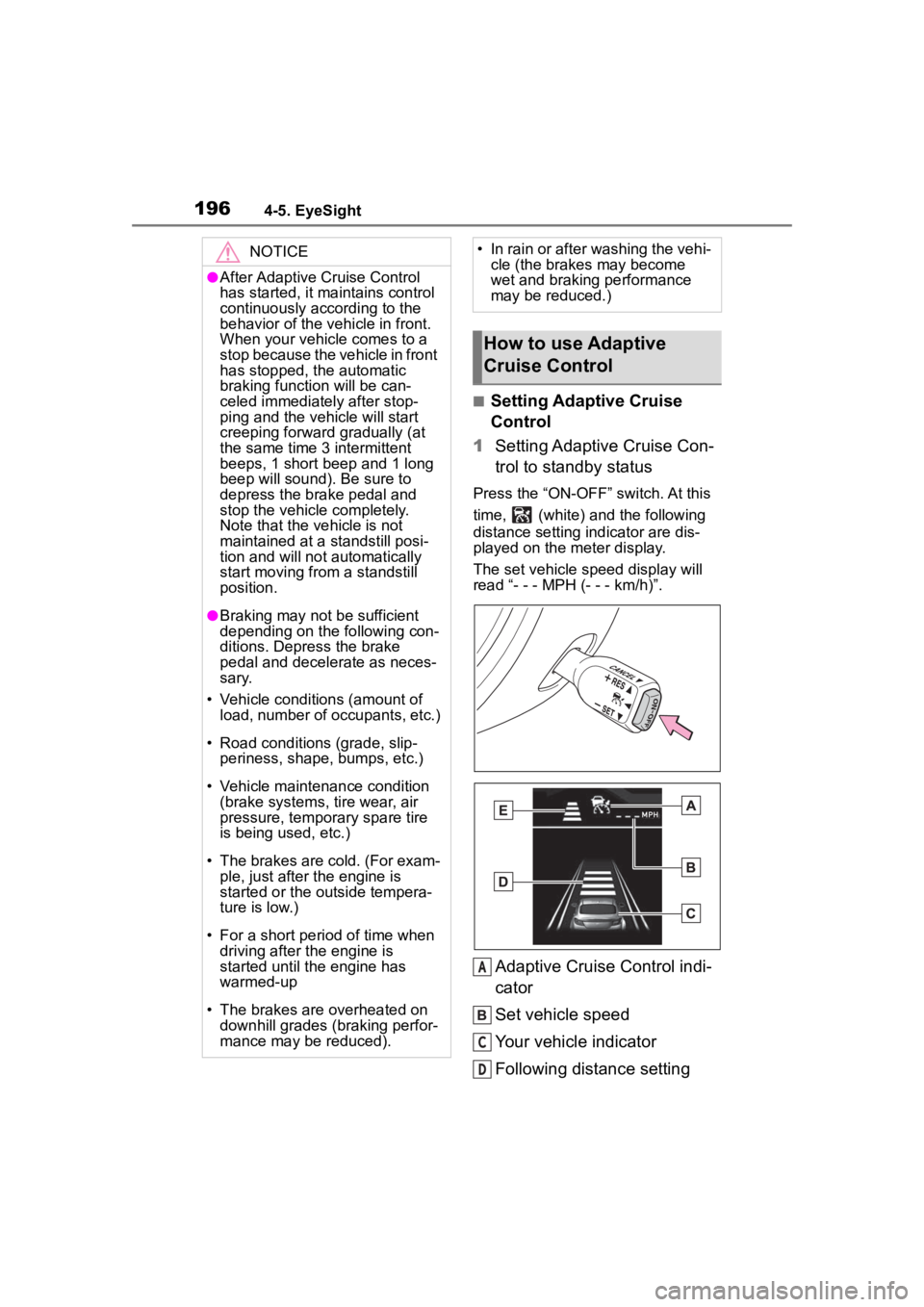
1964-5. EyeSight
■Setting Adaptive Cruise
Control
1 Setting Adaptive Cruise Con-
trol to standby status
Press the “ON-OFF” switch. At this
time, (white) and the following
distance setting indicator are dis-
played on the meter display.
The set vehicle speed display will
read “- - - MPH (- - - km/h)”.
Adaptive Cruise Control indi-
cator
Set vehicle speed
Your vehicle indicator
Following distance setting
NOTICE
●After Adaptive Cruise Control
has started, it maintains control
continuously according to the
behavior of the vehicle in front.
When your vehicle comes to a
stop because the vehicle in front
has stopped, the automatic
braking function will be can-
celed immediately after stop-
ping and t he vehicle will start
creeping forward gradually (at
the same time 3 intermittent
beeps, 1 short beep and 1 long
beep will sound). Be sure to
depress the brake pedal and
stop the vehicle completely.
Note that the vehicle is not
maintained at a standstill posi-
tion and will not automatically
start moving from a standstill
position.
●Braking may not be sufficient
depending on the following con-
ditions. Depress the brake
pedal and decelerate as neces-
sary.
• Vehicle conditions (amount of load, number of occupants, etc.)
• Road conditions (grade, slip- periness, shape, bumps, etc.)
• Vehicle maintenance condition (brake systems, tire wear, air
pressure, temporary spare tire
is being used, etc.)
• The brakes are cold. (For exam- ple, just after the engine is
started or the outside tempera-
ture is low.)
• For a short period of time when driving after the engine is
started until the engine has
warmed-up
• The brakes are overheated on downhill grades (braking perfor-
mance may be reduced).
• In rain or after washing the vehi- cle (the brakes may become
wet and braking performance
may be reduced.)
How to use Adaptive
Cruise Control
A
C
D
Page 199 of 449
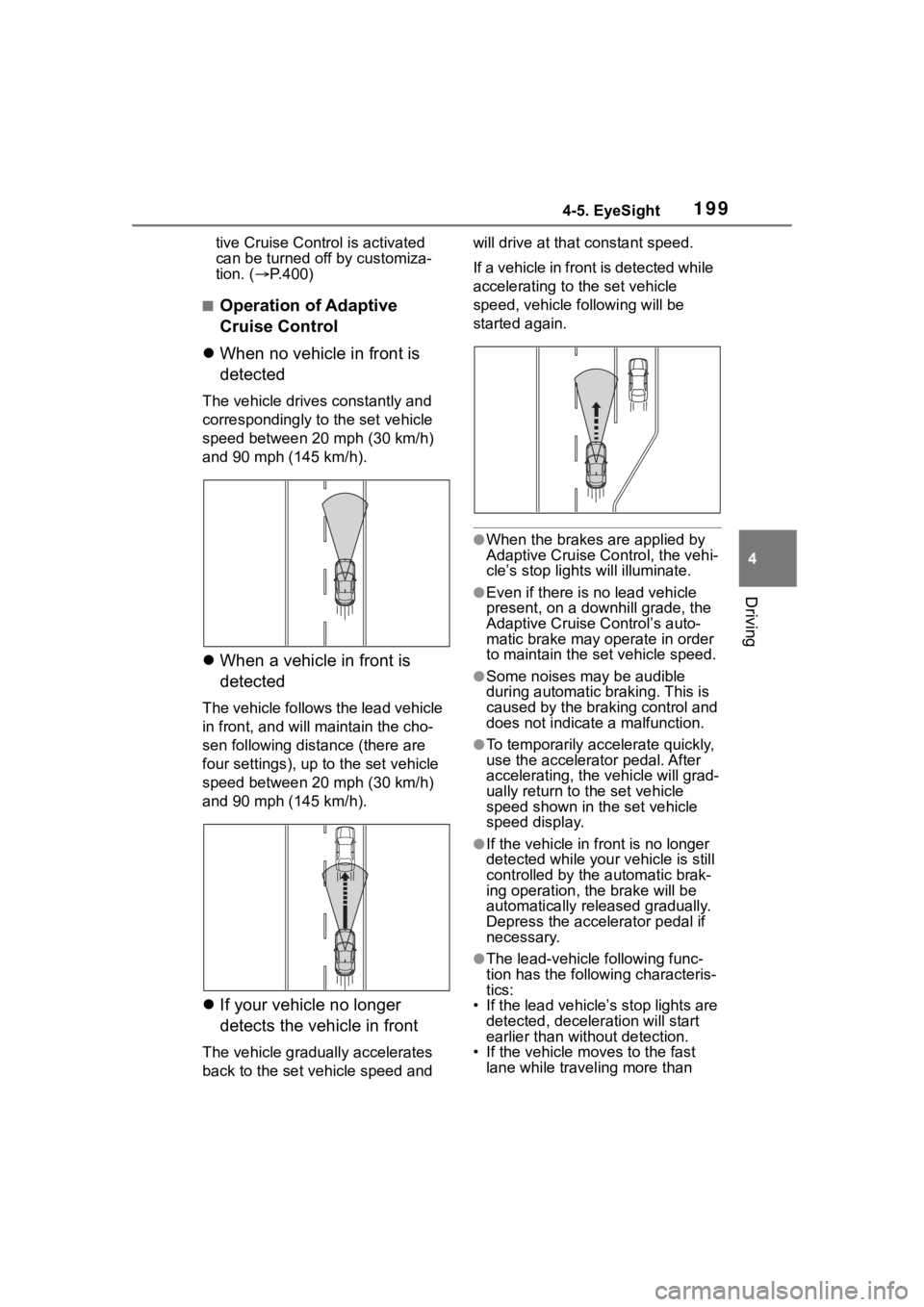
1994-5. EyeSight
4
Driving
tive Cruise Control is activated
can be turned off by customiza-
tion. (P.400)
■Operation of Adaptive
Cruise Control
When no vehicle in front is
detected
The vehicle drives constantly and
correspondingly to the set vehicle
speed between 20 mph (30 km/h)
and 90 mph (145 km/h).
When a vehicle in front is
detected
The vehicle follows the lead vehicle
in front, and will maintain the cho-
sen following distance (there are
four settings), up to the set vehicle
speed between 20 mph (30 km/h)
and 90 mph (145 km/h).
If your vehicle no longer
detects the vehicle in front
The vehicle gradually accelerates
back to the set vehicle speed and will drive at that constant speed.
If a vehicle in fron
t is detected while
accelerating to the set vehicle
speed, vehicle following will be
started again.
●When the brakes are applied by
Adaptive Cruise Co ntrol, the vehi-
cle’s stop lights will illuminate.
●Even if there is no lead vehicle
present, on a downhill grade, the
Adaptive Cruise Control’s auto-
matic brake may op erate in order
to maintain the set vehicle speed.
●Some noises may be audible
during automatic braking. This is
caused by the braking control and
does not indicate a malfunction.
●To temporarily acce lerate quickly,
use the accelerator pedal. After
accelerating, the v ehicle will grad-
ually return to the set vehicle
speed shown in the set vehicle
speed display.
●If the vehicle in front is no longer
detected while your vehicle is still
controlled by the automatic brak-
ing operation, the brake will be
automatically released gradually.
Depress the accelerator pedal if
necessary.
●The lead-vehicle following func-
tion has the following characteris-
tics:
• If the lead vehicle’s stop lights are
detected, deceler ation will start
earlier than without detection.
• If the vehicle moves to the fast
lane while traveling more than
Page 208 of 449
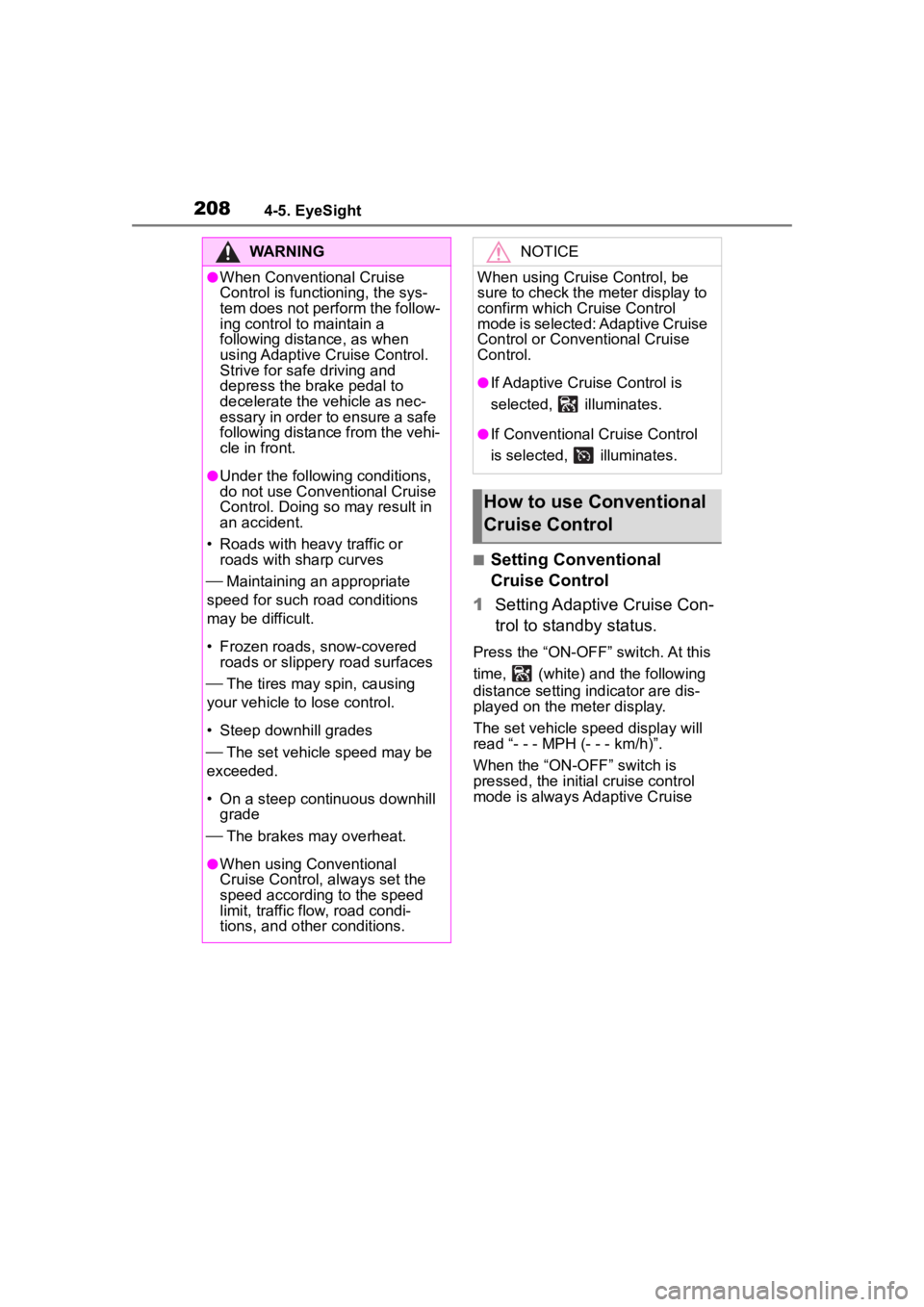
2084-5. EyeSight
■Setting Conventional
Cruise Control
1 Setting Adaptive Cruise Con-
trol to standby status.
Press the “ON-OFF” switch. At this
time, (white) and the following
distance setting indicator are dis-
played on the meter display.
The set vehicle speed display will
read “- - - MPH (- - - km/h)”.
When the “ON-OFF” switch is
pressed, the initial cruise control
mode is always Adaptive Cruise
WARNING
●When Conventional Cruise
Control is functioning, the sys-
tem does not perform the follow-
ing control to maintain a
following distance, as when
using Adaptive Cruise Control.
Strive for safe driving and
depress the brake pedal to
decelerate the vehicle as nec-
essary in order to ensure a safe
following distance from the vehi-
cle in front.
●Under the following conditions,
do not use Conventional Cruise
Control. Doing so may result in
an accident.
• Roads with heavy traffic or roads with sharp curves
Maintaining an appropriate
speed for such road conditions
may be difficult.
• Frozen roads, snow-covered roads or slippery road surfaces
The tires may spin, causing
your vehicle to lose control.
• Steep downhill grades
The set vehicle speed may be
exceeded.
• On a steep continuous downhill grade
The brakes may overheat.
●When using Conventional
Cruise Control, always set the
speed according to the speed
limit, traffic flow, road condi-
tions, and other conditions.
NOTICE
When using Cruise Control, be
sure to check the meter display to
confirm which Cr uise Control
mode is selected: Adaptive Cruise
Control or Conventional Cruise
Control.
●If Adaptive Cruise Control is
selected, illuminates.
●If Conventional Cruise Control
is selected, illuminates.
How to use Conventional
Cruise Control
Page 240 of 449

2404-6. Using other driving systems
*: If equipped
The Reverse Automatic Braking
(RAB) system records and stores
the following data when automatic
braking operates. It does not record
conversations, personal information
or other audio data.
●Distance from the object
●Vehicle speed
●Accelerator pedal operation status
●Brake pedal operation status
●Shift lever position
●Outside temperature
●The sensitivity setting of the sonar
sensors
Toyota and third parties contracted
by Toyota may acquire and use the
recorded data for the purpose of
vehicle research and development.
Toyota and third parties contracted
by Toyota will not disclose or pro-
vide the acquired data to any other
third party except under the follow-
ing conditions.
●The vehicle owner has given
his/her consent.
●The disclosure/prov ision is based
NOTICE
●Always keep the bumper sur-
face near the radar sensors
clean.
●Do not affix any stickers or other
items on the bumper surface
near the radar sensors. For
details, consult your Toyota
dealer.
●Do not modify the bumper near
the radar sensors.
●Do not paint the bumper near
the radar sensors.
●Do not expose the bumper near
the radar sensors to strong
impacts. If a sensor becomes
misaligned, a system malfunc-
tion may occur, including the
inability to detect vehicles enter-
ing the detection areas. If any
strong shock is applied to the
bumper, be sure to contact your
Toyota dealer for inspection.
●Do not disassemble the radar
sensors.
Reverse Automatic
Braking (RAB) system*
Reverse Automatic Braking
(RAB) is a system designed
to help avoid collisions or
reduce collision damage
when reversing the vehicle.
If a wall or an obstacle is
detected in the reversing
direction, the system will
notify the driver with a
warning sound and may
activate the vehicle’s brakes
automatically.
Page 262 of 449
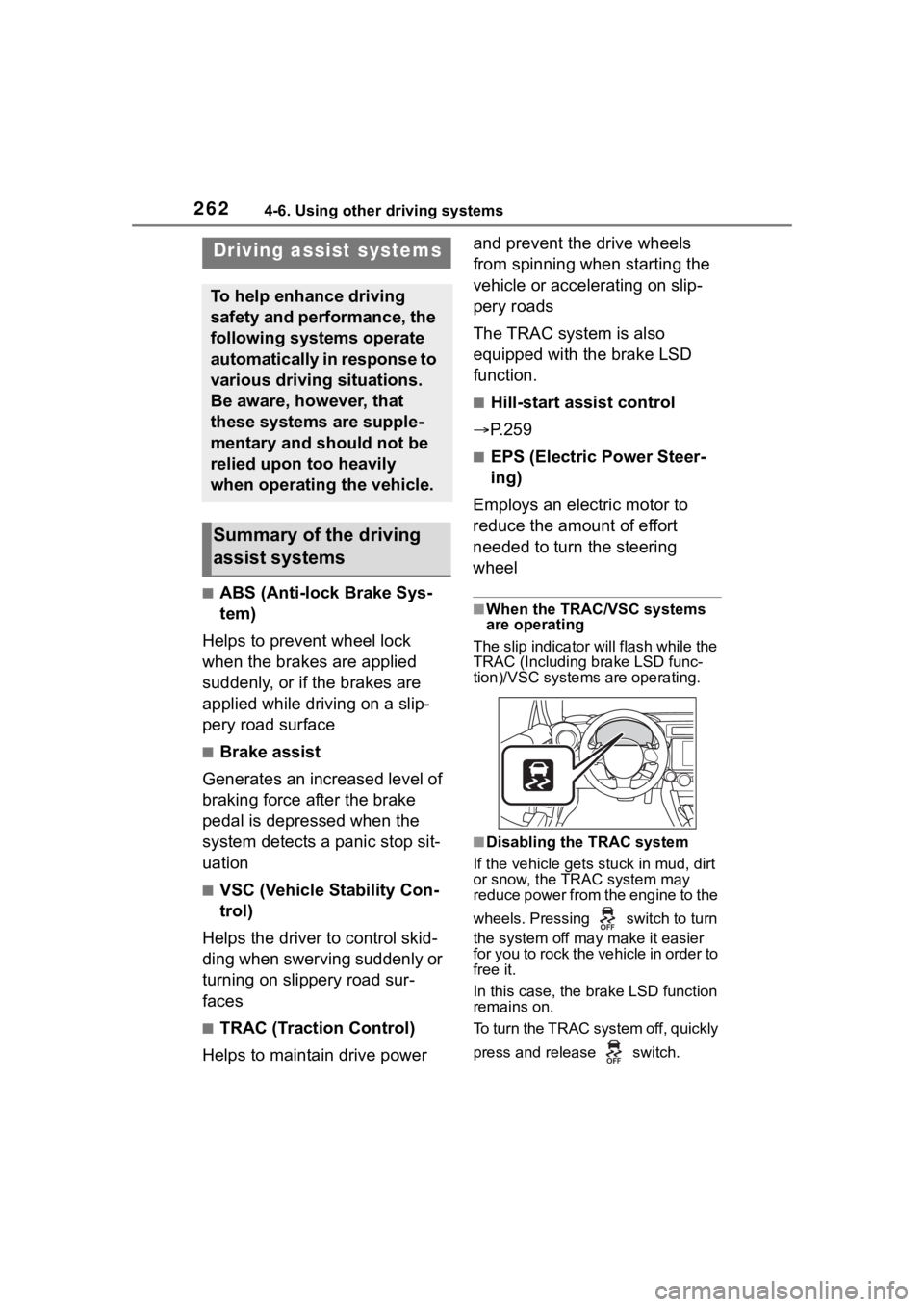
2624-6. Using other driving systems
■ABS (Anti-lock Brake Sys-
tem)
Helps to prevent wheel lock
when the brakes are applied
suddenly, or if the brakes are
applied while driving on a slip-
pery road surface
■Brake assist
Generates an increased level of
braking force after the brake
pedal is depressed when the
system detects a panic stop sit-
uation
■VSC (Vehicle Stability Con-
trol)
Helps the driver to control skid-
ding when swerving suddenly or
turning on slippery road sur-
faces
■TRAC (Traction Control)
Helps to maintain drive power and prevent the drive wheels
from spinning when starting the
vehicle or accelerating on slip-
pery roads
The TRAC system is also
equipped with the brake LSD
function.
■Hill-start assist control
P.259
■EPS (Electric Power Steer-
ing)
Employs an electric motor to
reduce the amount of effort
needed to turn the steering
wheel
■When the TRAC/VSC systems
are operating
The slip indicator will flash while the
TRAC (Including brake LSD func-
tion)/VSC systems are operating.
■Disabling the TRAC system
If the vehicle gets stuck in mud, dirt
or snow, the TRAC system may
reduce power from the engine to the
wheels. Pressing switch to turn
the system off may make it easier
for you to rock the vehicle in order to
free it.
In this case, the brake LSD function
remains on.
To turn the TRAC system off, quickly
press and release switch.
Driving assist systems
To help enhance driving
safety and performance, the
following systems operate
automatically in response to
various driving situations.
Be aware, however, that
these systems are supple-
mentary and should not be
relied upon too heavily
when operating the vehicle.
Summary of the driving
assist systems
Page 267 of 449
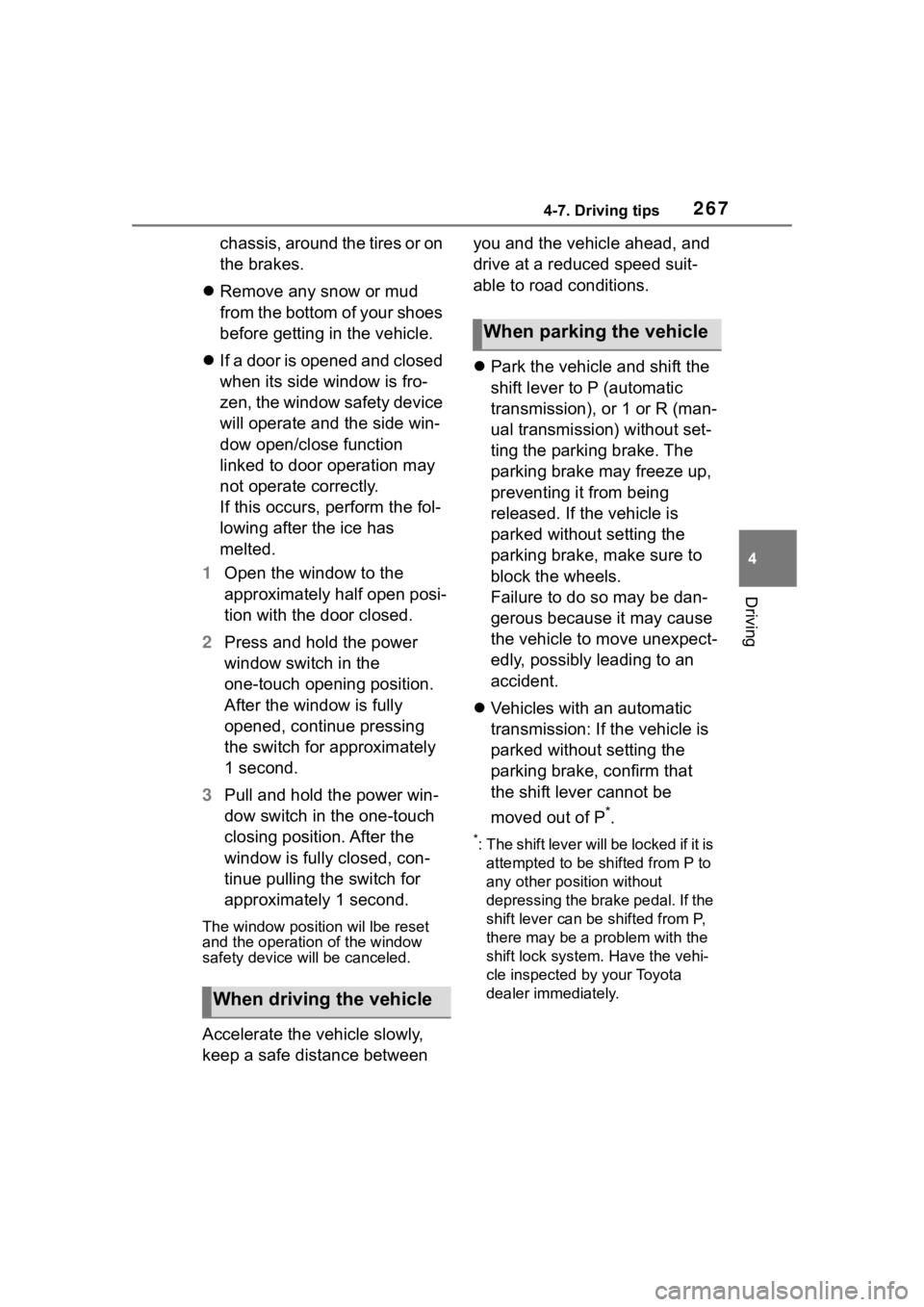
2674-7. Driving tips
4
Driving
chassis, around the tires or on
the brakes.
Remove any snow or mud
from the bottom of your shoes
before getting in the vehicle.
If a door is opened and closed
when its side window is fro-
zen, the window safety device
will operate and the side win-
dow open/close function
linked to door operation may
not operate correctly.
If this occurs, perform the fol-
lowing after the ice has
melted.
1 Open the window to the
approximately half open posi-
tion with the door closed.
2 Press and hold the power
window switch in the
one-touch opening position.
After the window is fully
opened, continue pressing
the switch for approximately
1 second.
3 Pull and hold the power win-
dow switch in the one-touch
closing position. After the
window is fully closed, con-
tinue pulling the switch for
approximately 1 second.
The window position wil lbe reset
and the operation of the window
safety device will be canceled.
Accelerate the vehicle slowly,
keep a safe distance between you and the vehicle ahead, and
drive at a reduced speed suit-
able to road conditions.
Park the vehicle and shift the
shift lever to P (automatic
transmission), or 1 or R (man-
ual transmission) without set-
ting the parking brake. The
parking brake may freeze up,
preventing it from being
released. If the vehicle is
parked without setting the
parking brake, make sure to
block the wheels.
Failure to do so may be dan-
gerous because it may cause
the vehicle to move unexpect-
edly, possibly leading to an
accident.
Vehicles with an automatic
transmission: If the vehicle is
parked without setting the
parking brake, confirm that
the shift lever cannot be
moved out of P
*.
*: The shift lever will be locked if it is
attempted to be sh ifted from P to
any other position without
depressing the brake pedal. If the
shift lever can be shifted from P,
there may be a problem with the
shift lock system. Have the vehi-
cle inspected by your Toyota
dealer immediately.
When driving the vehicle
When parking the vehicle
Page 289 of 449
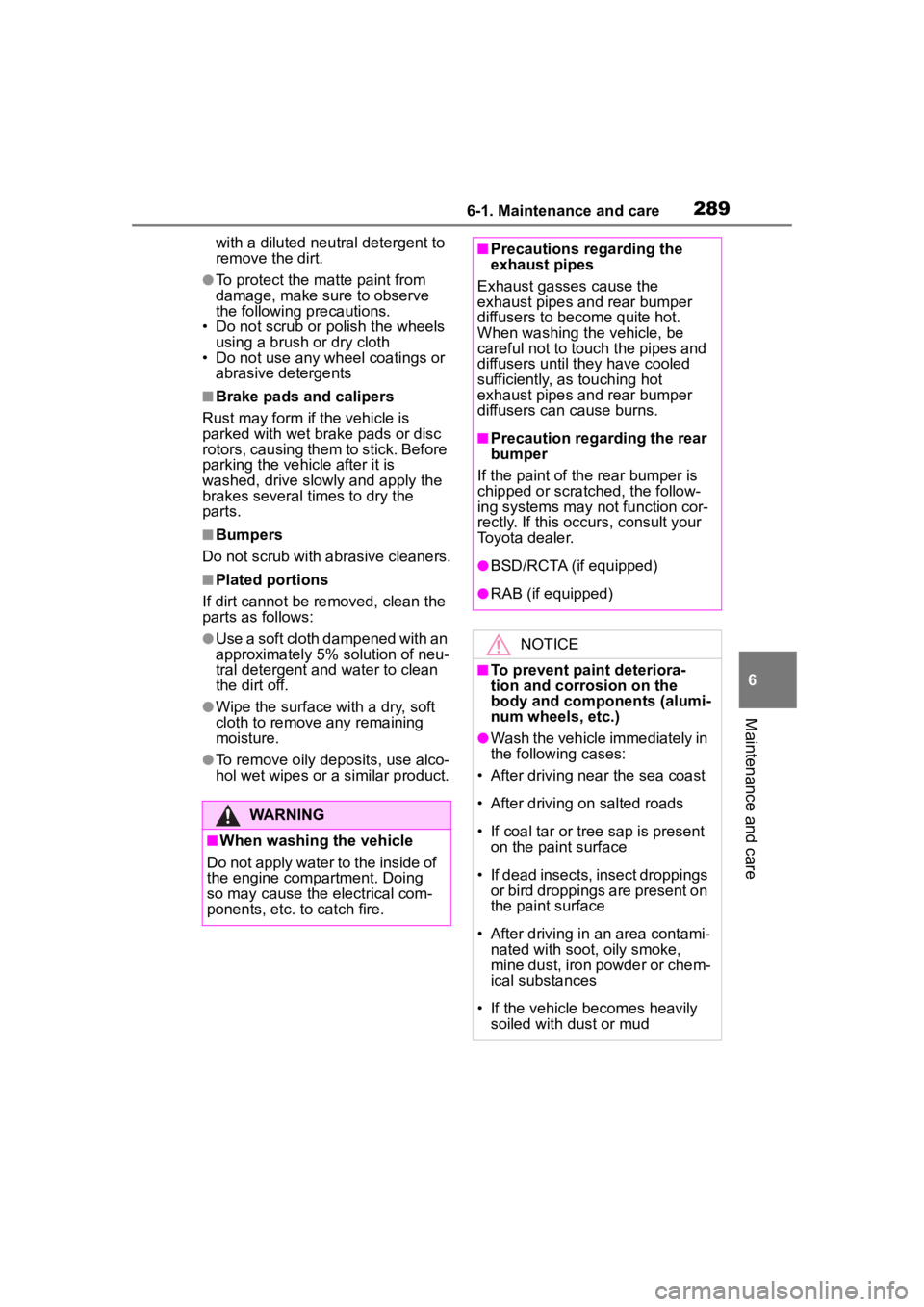
2896-1. Maintenance and care
6
Maintenance and care
with a diluted neutral detergent to
remove the dirt.
●To protect the matte paint from
damage, make sure to observe
the following precautions.
• Do not scrub or polish the wheels using a brush or dry cloth
• Do not use any wheel coatings or
abrasive detergents
■Brake pads and calipers
Rust may form if the vehicle is
parked with wet brake pads or disc
rotors, causing them to stick. Before
parking the vehicle after it is
washed, drive slow ly and apply the
brakes several times to dry the
parts.
■Bumpers
Do not scrub with abrasive cleaners.
■Plated portions
If dirt cannot be removed, clean the
parts as follows:
●Use a soft cloth dampened with an
approximately 5% solution of neu-
tral detergent and water to clean
the dirt off.
●Wipe the surface with a dry, soft
cloth to remove any remaining
moisture.
●To remove oily deposits, use alco-
hol wet wipes or a similar product.
WARNING
■When washing the vehicle
Do not apply water to the inside of
the engine compartment. Doing
so may cause the electrical com-
ponents, etc. to catch fire.
■Precautions regarding the
exhaust pipes
Exhaust gasses cause the
exhaust pipes and rear bumper
diffusers to become quite hot.
When washing the vehicle, be
careful not to touch the pipes and
diffusers until they have cooled
sufficiently, as touching hot
exhaust pipes and rear bumper
diffusers can cause burns.
■Precaution regarding the rear
bumper
If the paint of th e rear bumper is
chipped or scratched, the follow-
ing systems may not function cor-
rectly. If this occurs, consult your
Toyota dealer.
●BSD/RCTA (if equipped)
●RAB (if equipped)
NOTICE
■To prevent paint deteriora-
tion and corrosion on the
body and components (alumi-
num wheels, etc.)
●Wash the vehicle immediately in
the following cases:
• After driving nea r the sea coast
• After driving on salted roads
• If coal tar or tree sap is present on the paint surface
• If dead insects, insect droppings or bird droppings are present on
the paint surface
• After driving in an area contami- nated with soot, oily smoke,
mine dust, iron powder or chem-
ical substances
• If the vehicle becomes heavily soiled with d ust or mud